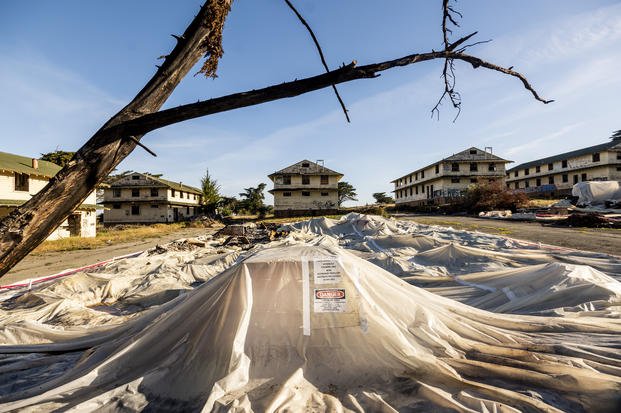A ship poisoning its own crew by mixing fuel into its water. Extremist groups targeting service members and veterans for recruitment. An ongoing shroud of uncertainty surrounding accidents harming troops aboard Osprey aircraft. A recruiter accused of grooming a young prospective Marine, and then bragging about his actions in a self-published memoir.
Those are just some of the stories the Military.com newsroom unearthed in 2023. Sometimes, our reporting yielded important information with only a couple of days of shoe leather. Sometimes, the journalism was the work of years of careful investigation.
All of these stories helped the military community understand what was happening, and helped some receive the care and benefits they’d earned through their service.
This year, the reporting team also received recognition for investigations published in 2022, including the Joe Galloway Award from MRE and an honorable mention from the Gerald R. Ford Awards, both for this deep investigation into traumatic brain injury in the military community. Two Military.com reporters also were honored for being among the top 10 veterans in journalism by MVJ for their reporting on American veterans fighting in Ukraine, and on a church accused of scamming veterans.
Here’s an unranked list of the Top 10(ish) stories written by Military.com for 2023, many of which will likely land on awards lists released this coming year.
Service often entails a certain amount of health and safety risk. But in one case documented by Military.com, the hazard for the crew of the USS Boxer was entirely preventable and the lack of documentation problematic for those sickened troops when they sought help and compensation.
The multiyear investigation revealed that crew members on the ship had dumped fuel into the ocean, only to suck that same fuel back up into the ship’s water system, forcing sailors and Marines to drink and bathe in tainted water. Years later, when some sought help from the Department of Veterans Affairs, they found that the Navy didn’t keep any documentation about the 2016 incident.
As part of Military.com’s reporting, the Navy, for the first time, publicly acknowledged the event. Former crew members have been using that acknowledgment and the article’s description of the fuel dump to seek benefits and, in at least one case, a previous claim denial was reversed.

No issue drove concern among military leadership quite like the alarming shortages in recruiting. Even the smaller services that managed to hit recruiting targets barely cleared the mark, and often had to rely on reserves of deferred-entry recruits to make quota.
Why the military is struggling to attract young talent is the subject of raging debate, both in the military community and among politicians who have chosen the issue as a mechanism to highlight their favored issues.
Military.com covered the wide range of techniques the services are using to try to make up for the shortfall, including massive increases to bonuses and specialized pre-basic training camps designed to help recruits meet service standards. (While not included in the Top 10 for thematic reasons, this feature on the course designed for potential soldiers who haven’t met the academic standards of the service is a must read” ‘Last Stop USA’: How the Army Is Trying to Fill in for a Broken Education System.)

If you want to understand the policy alterations that are changing life for those in the enlisted ranks, it’s often very important to understand those services’ enlisted leaders.
These two features look at the men who were departing key positions with the Army and Space Force, respectively.
The common theme between the two is how these leaders leaned on personal experience and the empathy that imbued in them to try to make changes to help those in uniform and shape cultures that were supportive.

The number of veterans who were identified as participating in the Jan. 6 attack on the U.S. Capitol has led to a lot of questions about radicalization in the military community. Four Military.com reporters spent more than a year working to investigate the ways extremist groups target those in the military community.
The resulting three-part series detailed how the groups initially lure service members and veterans, the rise of the threat posed by these extremist groups, and what the military has and hasn’t done to try to make sure troops aren’t susceptible to recruitment.
The series paints a picture of groups that recognize the inherent credibility and knowledge that can be gained by putting veterans in prominent positions, as well as particular moments of vulnerability for vets that make them easier targets. It also shows that the interest in combating the problem quickly faded after the topic became highly politicized, and ongoing efforts are minimal.

The services experienced a series of Osprey crashes in the past year and, while the causes of all of them aren’t entirely known at this time, a long-recognized mechanical issue has put the safety record of the aircraft back in the spotlight.
This feature revealed the details of one past incident with the mechanical flaw the military has struggled to fix resulting in repeated grounding of the aircraft. While the services downplayed the clutch problem, this story showed just how debilitating failure of the component could be, putting service members’ lives at risk.
Another crash late in the year, the deadliest in the history of the Air Force’s use of the platform, has led to a congressional inquiry into the safety of the Osprey.

The PACT Act represented one of the largest expansions of VA benefits in the agency’s history, but not all veterans were included. This article detailed how some veterans, exposed to toxins while serving at military installations not mentioned in the PACT Act, were left out of the opportunity to get help.
In addition to highlighting the issues these veterans face, this story also serves as a preview for four separate investigations all underway by Military.com reporters that are part of a project supported by the Pulitzer Center.
The publication always closely covers VA benefits, but this project will look at several major issues tied to veterans health and health care, with more in-depth investigations set to be published in early 2024.

The relationship between recruiters and potential service members is under renewed scrutiny as the services look to improve recruiting in the face of weak numbers. But the inherent power dynamic, where an adult holds tremendous authority over often underage kids desperate to fulfill dreams of service, creates clear opportunity for abuse.
This story detailed accusations against a Marine recruiter who self-published a memoir that outlined a sexual relationship with a recruit that allegedly began when she was underage.
After the initial report, the victim described that she received threatening messages from the recruiter, and Military.com continued to report on the situation and the lack of action by the service.

Sometimes, themes that are prevalent across America, like crushing medical debt, appear in the military community despite programs and policies that should insulate service members.
In this report, Military.com disclosed how a dual-military couple had been getting harassing calls after their daughter had a medically complicated birth that should have been covered by military health care.
It was only after they turned to social media that an Army official personally intervened, and the debt was eliminated, but it’s a reminder that, even in a system that is designed to guarantee health benefits, consistent monitoring and advocacy is crucial.

A lot of service members are inked. The art serves as an opportunity to remember important moments and people, a form of self-expression in an environment where conformity is the norm, and a means of bonding with those who have shared a foxhole.
This episode of the Fire Watch podcast saw the show’s host travel to a tattoo museum to better understand the art form, in addition to recording himself getting a new tattoo while talking to a fellow vet about what ink means to them.
While most of the journalism carried out by Military.com appears as written articles on the website, this year saw several compelling episodes of Fire Watch, including one that helped reveal the struggle by the family of Col. Paris D. Davis to help him receive the Medal of Honor he clearly deserved, and an inside account of a fight against a terrorist group in Somalia.
Subscribe to Fire Watch on Spotify, Apple Podcasts, or wherever you get your podcasts.

At a time when the services are struggling to attract new recruits, Military.com broke the news that the National Guard hadn’t paid out enlistment bonuses to at least 9,000 soldiers promised sums for signing on the dotted line.
Thousands of those soldiers completed their service without receiving the bonuses, with officials trying to fix issues with the Army tracking systems to deal with the massive backlog.
“I did my end of things, and this is a really bad introduction to the Army, not taking care of people,” one affected soldier told Military.com.
Honorable Mention
We focus our coverage on the issues impacting the military community at Military.com, meaning that we don’t tend to cover pie-in-the-sky ideas when it comes to prospective technology. But what if that technology is planted inside troops’ heads and is a lot closer to reality than science fiction? That question led to an investigation into ongoing research about bioenhancement for troops and, in particular, efforts to link brains to computers.
(Editor’s Note: This article was excluded from the formal top 10 list given that Military.com Managing Editor Zachary Fryer-Biggs shared a byline on the feature.)
Story Continues
Please rate this CIBA article
Vote






